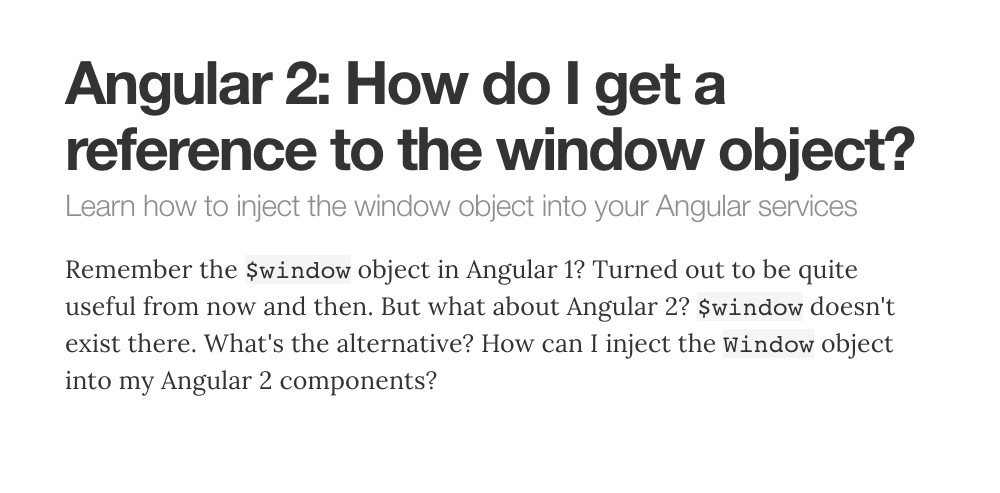Angular: How do I get a reference to the window object?


Remember the $window object in Angular 1? Turned out to be quite useful from now and then. But what about Angular? $window doesn’t exist there. What’s the alternative? How can I inject the Window object into my Angular components?
Contents are based on Angular version >= 2
Referencing global browser objects like document or window directly from within your code is possible, but not encouraged and considered bad practice.
You want to register only events on window or document? Then you may want to read this also:
Learn about @HostListener and host binding properties to register event listeners on the document object
Especially Angular isn’t only designed to run within your browser, but also on mobiles, the server or web workers where objects like window may not be available.
Therefore the suggested approach is to wrap such objects and inject them through the dependency injection mechanism. This way it is possible to change the concrete runtime instance of a given object based on the environment the Angular application is running. The result we wanna achieve is the following:
...
import { WindowRef } from './WindowRef';
@Component({...})
class MyComponent {
constructor(private winRef: WindowRef) {
// getting the native window obj
console.log('Native window obj', winRef.nativeWindow);
}
}
So let’s see.
Wrapping window
A very straightforward and easy way to wrap window is by creating an Angular service. That’s as easy as creating an ES6 class and decorating it with @Injectable.
import { Injectable } from '@angular/core';
function _window() : any {
// return the global native browser window object
return window;
}
@Injectable()
export class WindowRef {
get nativeWindow() : any {
return _window();
}
}
Register WindowRef as provider
Great, so far we’ve wrapped our window object. We aren’t ready yet, however. We first need to register our injectable service. This is done by registering it on the NgModule’s providers array or directly on the component, based on the scope of our provider. Check out the official docs on providers for more details.
import { WindowRef } from './WindowRef';
...
@NgModule({
...
providers: [ WindowRef ]
})
export class AppModule{}
Try it yourself
Great, we’re ready. You can now inject the WindowRef into your Angular components and get access to the native window object.
Here’s a Plunker to play around with: https://plnkr.co/edit/9qmBCVrmBZj3mPQjM0Zc?p=preview
You want to register only events on window or document? Then you may want to read this also:
Learn about @HostListener and host binding properties to register event listeners on the document object